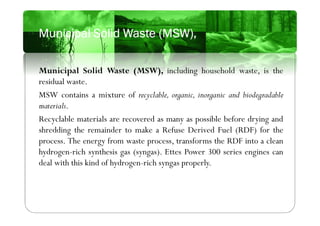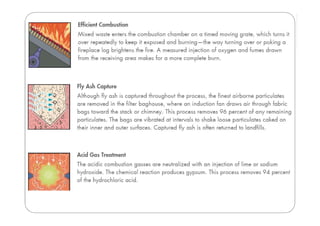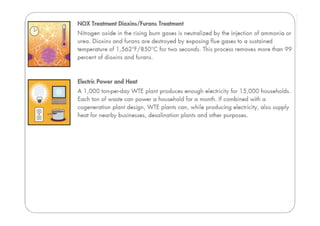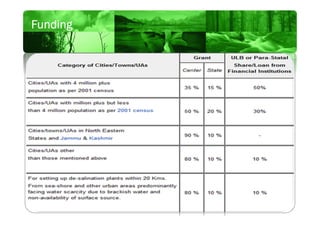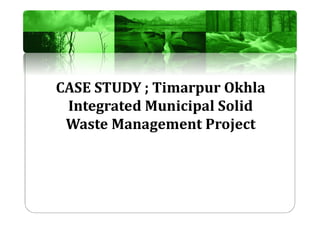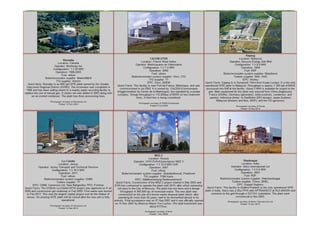Waste to energy
- 1. WASTETO ALTERNATIVE ENERGY FUNDAMENTALS PREPARED BY: DEEPIKA VERMA (15001506003) M. Arch, 3rd Semester DCRUST, MURTHAL PRESENTATION - 1
- 2. CONTENTS • INTRODUCTION (WASTE TO ENERGY) • WHY WASTE TO ENERGY • TECHNOLOGICAL OVERVIEW • STATISTICS • COMMERCIAL VIABILITY • GOVERNMENT POLICIES • COMPETING TECNOLOGY • CASE STUDY
- 3. Waste-to-energy (WtE) or energy-from-waste (EfW) is the process of generating energy in the form of electricity and/or heat from the primary treatment of waste. WtE is a form of energy recovery. Most WtE processes produce electricity and/or heat directly through combustion, or produce a combustible fuel commodity, such as methane, methanol, ethanol or synthetic fuels. Waste-to-energy technologies convert waste matter into various forms of fuel that can be used to supply energy. Waste feed stocks can include municipal solid waste (MSW); construction and demolition (C&D) debris; agricultural waste, such as crop silage and livestock manure; industrial waste from coal mining, lumber mills, or other facilities; and even the gases that are naturally produced within landfills. WASTE TO ENERGY
- 4. WHY WASTE TO ENERGY? Waste-to-energy technologies can address two sets of environmental issues at one stroke – land use and pollution from landfills, and the well-know environmental perils of fossil fuels. However, waste-to-energy systems can be expensive and often limited in the types of waste they can use efficiently; only some can be applied economically today.
- 5. Municipal Solid Waste (MSW), including household waste, is the residual waste. MSW contains a mixture of recyclable, organic, inorganic and biodegradable materials. Recyclable materials are recovered as many as possible before drying and shredding the remainder to make a Refuse Derived Fuel (RDF) for the process. The energy from waste process, transforms the RDF into a clean hydrogen-rich synthesis gas (syngas). Ettes Power 300 series engines can deal with this kind of hydrogen-rich syngas properly. Municipal Solid Waste (MSW),
- 10. 1 2 3 WASTE TO ENERGY PLANT DIAGRAM
- 15. TECHONOLGY SELECTION CONSIDERATIONS • CO2 Control • DXNs Control • Emission Control • Landfill Control Environment • Cost Control • Profit • GrowthEconomy • Energy Recovery • High Efficiency • Utilization / SaleEnergy • Waste type • Waste quality • Waste content Waste Characteristics
- 16. ECONOMY FINANCIAL ESTIMATES FOR 1000 TPD PLANT CAPACITY
- 17. Mass and Energy Balance Technology Plant Capacities (TPD MSW) Power Generation Potential (MW /100TPD) Biomethanation 150, 350, 500 and 1000 1 Landfill with Gas recover 100 0.4 Gasification 500 2 Compositing NA NA Incineration 500 1.24
- 18. HIGHLIGHTS OF SOME ONGOING /PROPOSED MSW WTE PROJECTS IN INDIA
- 22. Commercial Viability GOI have provided assistance to the tune of Rs.2500 crores under 12th Finance Commission for SWM. Income Tax relief has also been provided to waste management agencies and Tax free municipal bonds have been permitted by GOI. The 11th Five Year Plan has envisaged an investment of Rs.2212 crores for SWM. Private Sector Participation in SWM: The private sector has been involved in door-to door collection of solid waste, street sweeping in a limited way, secondary storage and transportation and for treatment and disposal of waste. Cities which have pioneered in PPPs in SWM include Bangalore, Chennai, Hyderabad, Ahemdabad, Surat, Guwahati, Mumbai, Jaipur etc.
- 23. WHY NOW?
- 24. Funding
- 25. GOVERNMENT POLICIES The establishments providing wastes like industries, hospitals are required to follow the relevant Rules under the Environment Protection Act 1986 as follows: Hazardous Waste (Management and handling Rules),1989 Bio-medical Waste (Management and Handling Rules) 1998 Municipal Solid Waste (Management and Handling Rules 2000) GOI Initiatives for SWM Reforms Agenda (Fiscal, Institutional, Legal) Technical Manual on Municipal Solid Waste Management Technology Advisory Group on Municipal Solid Waste Management Inter-Ministerial Task Force on Integrated Plant Nutrient Management from city compost.
- 26. Tax Free Bonds by ULBs permitted by Government of India Income Tax relief to Waste Management agencies Public-Private Partnership in SWM Capacity Building Urban Reforms Incentive Fund Guidelines for PSP and setting up of Regulatory Authority Introduction of Commercial Accounting System in ULBs & other Sector Reforms Model Municipal Bye-Laws framed / circulated for benefit of ULBs for adoption Financial Assistance by Government of India - 12th Finance Commission Grants
- 27. ENVIRONMENTAL PERFORMANCE OF WTE
- 28. CASE STUDY ; Timarpur Okhla Integrated Municipal Solid Waste Management Project
- 29. ABOUT THE PROJECT Delhi generates 7,000 metric tonnes (MT) of Municipal Solid Waste (MSW) daily, which is expected to increase to 18,000 MT by 2021. The present landfill sites that are being utilized for disposing the garbage are approaching their full capacity and even with the envisaged capacity addition, the situation is unlikely to improve. The Municipal Corporation of Delhi (MCD) has thus embarked on a project to reduce the amount of MSW being disposed in the landfill sites and utilizing the waste for productive purposes such as generation of power from waste. MCD has identified two locations, namely Timarpur and Okhla, for implementing this project.
- 30. The following facilities are to be developed as a part of the integrated municipal waste handling project: 1. Plants for converting MSW to Refuse Derived Fuel (RDF), capable of processing 1300TPDat Okhla and 650TPD atTimarpur. 2. A bio-methanation plant capable of handling of 100TPD of green waste at Okhla. 3. A water recovery plant capable of handling up to 6 MLD of treated sewage at the Okhla site for recycling into process water and cooling water. 4. A Power plant with a generation capacity of 16 MW at Okhla. 5. Transportation of RDF from Timarpur to Okhla for combustion in the boiler of the power plant mentioned above. The project is registered with the United Nations Framework Convention on Climate Change (UNFCCC) for the Clean Development Mechanism (CDM) to earn 2.6 million Certified Emission Reductions (CERs) over a ten-year period.





